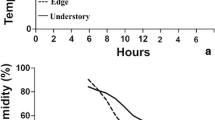Summary
Leaf longevity in 29 herbaceous plant species of Central Europe was studied by inspecting tagged leaves at weekly intervals. About half of the species are elements of the lowland meadow flora, the other half comprises a representative sample of species from the highest sites where vascular plants grow in the Alps. Shaded and water-stressed sites were avoided. Overall mean leaf longevity did not differ significantly between sites and amounted to 71±5 days at low and 68±4 days at high altitude. Leaf life spans ranged (with no clear altitudinal trend) from 41 to 95 days. Low-altitude forbs and grasses produced several leaf cohorts during their growth period, while most alpine species produced only one. Correlations were found between leaf duration and percent nitrogen content and carbon-cost/carbon-gain ratios, but not with leaf dry mass per unit leaf area and photosynthetic capacity alone. As leaf life spans increase, more C tends to be invested per unit CO2 uptake and less N is invested per unit invested C. Thus, mass relationships rather than area relationships seem to be linked to leaf life span in these species, suggesting that leaf duration is associated with properties other than the efficiency of light utilization (e.g. mechanical strength, herbivory or pathogen resistance). It seems that the explanations of leaf duration that have been developed for evergreen/deciduous plants and for plants along steep light gradients do not apply to the variable life spans in leaves of perennial herbaceous plants of open habitats.
Similar content being viewed by others
References
Bahn M, Körner Ch (1987) Vegetation und Phänologie der hochalpinen Gipfelflur des Glungezer in Tirol. Ber Nat-Med Ver Innsbruck 74:61–80
Bazzaz FA, Harper JL (1977) Demographic analysis of the growth of Linum usitatissimum. New Phytol 78:193–208
Chabot BF, Hicks DJ (1982) The ecology of leaf life spans. Annu Rev Ecol Syst 13:229–259
Chapin FS, Schulze ED, Mooney HA (1990) The ecology and economics of storage in plants. Annu Rev Ecol Syst 21: 423–447
Diemer MW (1990) Die Kohlenstoffbilanz von Blättern krautiger Pflanzen aus dem Hochgebirge und der Niederung. PhD thesis, Univ Innsbruck
Fliri F (1975) Das Klima der Alpen im Raume von Tirol. Univ Verlag Wagner, Innsbruck
Harper JL (1989) The value of a leaf. Oecologia 80:53–58
Hirose T, Werger MJA (1987) Maximizing daily canopy photosynthesis with respect to the leaf nitrogen allocation pattern in the canopy. Oecologia 72:520–526
Hodanova D (1981) Photosynthetic capacity, irradiance and sequential senescence of sugar beet leaves. Biol Plant (Prag) 23:58–67
Jurik TW (1983) Reproductive effort and dynamics of wild strawberry populations. Ecology 64:1329–1342
Jurik TW, Chabot BF (1986) Leaf dynamics and profitability in wild strawberries. Oecologia 69:296–304
Karlsson PS (1985) Effects of water and mineral nutrient supply on a deciduous and an evergreen dwarf shrub: Vaccinium uliginosum L. and V. vitis-idea L. Holarct Ecol 8:1–8
Koike T (1988) Leaf structure and photosynthetic performance as related to the forest succession of deciduous broad-leaved trees. Plant Spec Biol 3:77–87
Körner Ch (1984) Auswirkungen von Mineraldünger auf alpine Zwergsträucher. Verh Ges Ökol 12:123–136
Körner Ch (1989) The nutritional status of plants from high altitudes. A worldwide comparison. Oecologia 81:379–391
Körner Ch, Diemer M (1987) In situ photosynthetic responses to light, temperature and carbon dioxide in herbaceous plants from low and high altitude. Funct Ecol 1:179–194
Körner Ch, Pelaez Menendez-Riedl S (1989) The significance of developmental aspects in plant growth analysis. In: Lambers H et al. (eds) Causes and consequences of variation in growth rate and productivity of higher plants. SPB Acad Publ, The Hague, pp 141–157
Körner Ch, Neumayer M, Pelaez Menendez-Riedl S, Smeets-Scheel A (1989) Functional morphology of mountain plants. Flora 182:353–383
Larcher W (1963) Die Leistungsfähigkeit der CO2-Assimilation höherer Pflanzen unter Laboratoriumsbedingungen und am natürlichen Standort. Mitt Florist-Soziol Arbeitsgem N.F. 10:20–33
Maillette L (1986) Canopy development, leaf demography and growth dynamics of wheat and three weed species growing in pure and mixed stands. J Appl Ecol 23:929–944
Miller PC, Stoner WA (1979) Canopy structural and environmental interactions. In: Solbrig OT et al. (eds) Topics in plant population biology, Columbia Univ Press, New York, pp 428–458
Mitchley J (1988) Control of relative abundance of perennials in chalk grassland in Southern England. III. Shoot phenology. J Ecol 76:607–616
Mooney HA, Gulmon SL (1982) Constraints on leaf structure and function in reference to herbivory. BioScience 32:198–206
Moore DM (1982) Flora Europaea check-list and chromosome index. Cambridge Univ Press, Cambridge
Peters B (1980) The demography of leaves in a permanent pasture. PhD thesis, Univ of Wales
Reich PB (1987) Quantifying plant response to ozone: a unifying theory. Tree Physiol 3:63–91
Schmid B (1985) Clonal growth in grassland perennials. II. Growth form and fine-scale colonizing ability. J Ecol 73:809–818
Schulze ED, Fuchs M, Fuchs MI (1977) Spatial distribution of photosynthetic capacity and performance in a mountain spruce forest of Northern Germany. Oecologia 30:239–248
Schulze W, Schulze ED (1990) Insect capture and growth of the insectivorous Drosera rotundifolia L. Oecologia 82:427–429
Shaver GR (1983) Mineral nutrition and leaf longevity in Ledum palustre: the role of individual nutrients and the timing of leaf mortality. Oecologia 56:160–165
Southwood TRE, Brown VK, Reader PM (1986) Leaf palatability, life expectancy and herbivore damage. Oecologia 70:544–548
Sydes CL (1984) A comparative study of leaf demography in limestone grassland. J Ecol 72:331–345
Van Keulen H, Goudriaan J, Seligman NG (1989) Modelling the effects of nitrogen on canopy development and crop grwoth. In: Russell G, Marshall B, Jarvis PG (eds) Plant canopies: their growth, form and function. (soc Exp Biol Sem Ser 31) Cambridge Univ Press, pp 83–104
Williams K, Field CB, Mooney HA (1989) Relationships among leaf construction cost, leaf longevity, and light environment in rain-forest plants of the genus Piper. Am Nat 133: 198–211
Author information
Authors and Affiliations
Rights and permissions
About this article
Cite this article
Diemer, M., Körner, C. & Prock, S. Leaf life spans in wild perennial herbaceous plants: a survey and attempts at a functional interpretation. Oecologia 89, 10–16 (1992). https://doi.org/10.1007/BF00319009
Received:
Accepted:
Issue Date:
DOI: https://doi.org/10.1007/BF00319009




